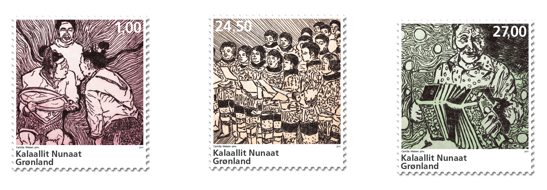POST Greenland: Greenlandic Music
This Article is taken from the magazine Greenland Collector vol 22, which is issued in January 2017.
Greenlandic Music
Music plays an important part in Greenland's culture and history. Every year, 10-15 CDs with Greenlandic music are released in Greenland. The best selling CDs are released in issues of 5,000 copies. This is rather impressive in a country of only 56,000 inhabitants.
It is therefore natural that we dedicate a whole series to Greenlandic music. Camilla Nielsen, who will be known to several of our collectors from earlier stamps, has created a total of six beautiful images reflecting the Greenlandic music through six different eras. The three first stamps, which will be issued on 23rd January, depict Greenlandic music in a very long time perspective, all the way from drum singing to accordion music. The stamps will be issued in normal sheets and printed in offset.
By Camilla Nielsen, artist:
It took a long time to create these three stamps, and I am very grateful for the co-operation with POST Greenland and Karsten Sommer, the music producer, in connection with this issue. It has been most interesting to co-operate with Karsten and on the basis of his comprehensive knowledge of Greenland's musical history to choose the three photos, which are used as sources of the final images of the stamp series, with him.
To me, it has been an exciting process to create an artistic concept on the basis of these three photos. And to examine how to connect the three photos in a single expression for an entire stamp series. The woodcuts made by Aron of Kangeq were sources of inspiration. As it appears from the stamps, I have chosen to enter the graphic world. In that way, the three source photos have been further processed in three line engravings on zinc plates, and the stamp images have been completed on a computer.
By Karsten Sommer, journalist and music producer:
Drum singing is the original form of music among the Inuit, and it is thousands of years old. Drum singing still exists today all the way from Siberia, Alaska and Canada to the Thule area and East Greenland. In Siberia, Alaska and Canada, the drums are much larger than in Greenland, but the function of the drums was the same in the original communities: the drum could be used to invoke the spirits and as a "legal" instrument, which was, for instance, used for settling disputes between two people by means of a war song. The person, who was able to make the audience laugh the most, had won! And the drum singing was also the unifying activity during parties, where all people would sing the songs together.
The photo, which is the basis of this stamp, was taken at the summer meeting "Aasivik 77" in Qullissat. Milika Kuitse from East Greenland was there, and it attracted much attention that the Aasivik movement embraced the drum songs and, among other things, released an album through the record company ULO, so that the modern-day audience could get to know its cultural music heritage again.
When the missionaries came to Greenland in the 18th century, drum singing was prohibited. The missionaries considered drum singing to be shamanic and ungodly. There are stories about drummers, who were tied up and mocked, while their drums were being destroyed. On the other hand, the missionaries offered the Inuit a new form of music - choral singing. And gradually, as people were christianised and began attending church, the joy of singing in chorus spread. And that joy is still there today. In every town and also in most settlements, there are local choirs, where the members sing both Christian and more worldly songs in the church and at festive occasions. The story inspiring the creation of this stamp comes from the CD "The Santa Summit Christmas Concert" released in 1995 by ULO, © The Santa Claus of Greenland Foundation.
In addition to the missionaries, other people also began to arrive in Greenland. And they brought another new form of music to the Inuit. Whalers from Europe travelled to the Greenlandic waters in order to procure the oil-rich whale blubber, which was in demand in the large European cities. The reason for this was that the larger cities had begun to use street lighting, and the street lights were fueled by whale blubber! So, when the ships were loaded with blubber (the meat was just thrown away), the whalers went ashore for a short while to meet the local people. They brought their favourite instruments with them, for instance the violin and the accordion. And when the party with the local people started, the whalers played and danced to their local polkas from Scandinavia, Scotland, Germany and other homelands. When the party began to draw to a close, bartering began to take place, and the local Greenlanders acquired accordions and violins. In that way, the polka music - kalattuut - came to Greenland. To this day, any Greenlander is able to dance the complicated dances involving fast swings and turns.
The photo on which this stamp is based, was taken in 1980, and it shows the popular musician Louis Andreassen of Nanortalik. He recorded the album "Qavaat", which consisted of settlement music from South Greenland. The bubbles in the picture symbolise the immiaq - home brew - placed by his side and putting him in high spirits for a number of brilliant recordings.
Karsten Sommer, born in 1969
Journalist and music producer. Has worked at the Danish Broadcasting Corporation for several years and, since 2004, at the Greenlandic Broadcasting Corporation (KNR). Produced the first Greenlandic album with the rock band Sume in 1973 at the music publisher Demos. Participated later in the establishment of the Greenlandic record company ULO in 1976. Moved to Greenland in 1986.
Camilla Nielsen's last three stamps in this music series will be issued in 2018.
The three stamps, and all specialty items, can be purchased directly at POST Greenland.

